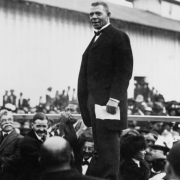Of all the various creations of the human mind, great art is the most difficult to understand because it is the most personal. To value art you must first know your explicitly defined values. To love a work of great art is to see or hear the concretization of these values in paintings, sculpture, music, novels, poetry, plays, movies or architecture. Great artists have perfected their ability to integrate abstract concepts into a philosophical theme and present it in concrete form for present and future generations. The finished work represents the artist’s sense of life. It is an emotional generalization of some of the artist’s highest values. It is selfish, not social; they do it without regard for the opinions of lesser minds.
Great novelists, poets and playwrights are able to express profound human emotion in very few words. The poet Shakespeare is famous for “brevity is the soul of wit.” In her novel The Fountainhead, Ayn Rand explained the artist’s attitude through her fictional architect Howard Roark, “I don’t build in order to have clients. I have clients in order to build.” For the first great artist in the Poetic Justice Warrior Series, it is important to recognize someone who was supremely independent, an innovator, overcame great obstacles, believed in the sanctity of human life, and whose work is spiritually accessible to mass audiences. Someone whose sense of life was marvelously conveyed in their art, and forever improved the human condition. This man, who loathed but tolerated the noble classes of his day wrote to his most powerful and wealthy patron and said,
Prince, what you are, you are through chance and birth; what I am, I am through my own labour. There are many princes and there will continue to be thousands more, but there is only one Beethoven.
In the late 18th and early 19th centuries, court musicians were considered to be of the same social class as any other servant – even the great Mozart dined with the cooks. Beethoven insisted on sitting at the head table with the royalty, and did so in street clothes. His talent was so magnetic and his improvisations so emotional that court etiquette was rendered optional.
Beethoven the Entrepreneur
The early 19th Century was a time of great political, social and technological upheaval. While Gutenberg‘s press was changing the world, printed music was difficult to create but becoming common. Also, mass produced pianos were taking hold and Beethoven saw the possibilities for being the first software publisher for this new hardware. For music lovers, if you wanted to hear Bach or Mozart you had to go to a concert in Germany. To hear a Beethoven piano sonata, he foresaw that you could buy sheet music and find someone local with a piano who could play it. His business model gradually changed from nobility and church patronage to publishing royalties, or as Beethoven explained in an 1801 letter to friend Franz Wegeler,
For every composition I can count on six or seven publishers, if I want them; people no longer come to an arrangement with me, I state my price and they pay. For instance, I see a friend in need and the state of my purse does not allow me to help immediately; I have only to sit down and compose and in a short time I can come to his aid.
Here, Beethoven stumbles across an abstract concept that had not yet been named: capitalism (producing something of value creates markets, profits, and unprecedented mass prosperity and benevolence). Two years later, the French classical economist Jean-Baptiste Say invented the word entrepreneur, described this phenomenon with his Treatise on Political Economy, and announced Say’s Law (the law of markets – humans must produce before they can consume).
Overcoming Adversity
Born in 1770 to a family of Flemish court musicians, young Ludwig was forced to take piano lessons from his physically abusive father and to endure sleep deprivation. But he persevered, his chosen passion being excellence in music. In 1800 he began noticing ringing in his ears, gradual hearing loss, and by the 1820s, total deafness and bouts of depression. This did not get in the way of his lifelong pursuit of excellence.
Also in 1800, a Prussian piano virtuoso, Daniel Steibelt, arrived in Vienna and challenged Beethoven to an improvisational piano contest with Vienna’s aristocracy in the audience. As the challenger, Steibelt would go first and the playing would go back and forth until a winner was declared. Steibelt finished and rose to great applause while a bored Beethoven took his turn at the piano. He played the first four notes of Steibelt’s piece, varied them, improvised on them, embellished them, unpicked Steibelt’s flourishes, parodied and mocked them. Steibelt stormed out never to return to Vienna and no one challenged Beethoven again.
Those first four notes became the foundation of Beethoven’s Symphony No. 3, known as Eroica, and one of his most celebrated works. It stretched the boundaries of classical composition in length, harmony, and content. Eroica is considered the landmark bridge to the Romantic era of great Western art that glorified man’s existence. But perhaps Beethoven’s finest achievement in the face of daunting obstacles is the spiritual Ninth Symphony. As early as 1793 he considered putting a musical setting to Friedrich Schiller‘s poem Ode to Freedom. But it wasn’t until 1815 that there is evidence of a sketch for the symphony’s theme, and it wasn’t finished until 1824 after living in utter deafness, mostly isolation, and being mistaken for a vagrant when out. He hadn’t performed publicly in years.
Ode to Freedom
According to music critic Irving Kolodin,
The Ninth owes to the Missa Solemnis the philosophical framework, the ideological atmosphere, the psychological climate in which it breathes and has its existence. Unlike the Missa however, it is a celebration of life, of man’s earthly possibilities rather than his heavenly speculations.
Missa had dominated Beethoven’s composing energy in the four years prior to finishing the Ninth. As philosopher Stephen Hicks says about Missa “He remained utterly faithful to his own experience. It is for this reason that his affirmative utterances, as in the Credo of the Mass in D [Missa], have such unexampled weight.” Musical historian Philip Downs tells us,
Music was not merely sounds to Beethoven. Music was an expression of the deepest human emotions, the greatest of human potentialities. To analyze Beethoven’s art for anything other than his comment on the human condition is to disregard the intent of one of the greatest composers in the history of mankind.
But it is in the fourth movement (commonly known as Ode to Joy) of the Ninth Symphony that his innovative skills were maximized. Beethoven used human voices, thereby creating the choral symphony, and deployed the largest orchestra ever. It was performed in Vienna in 1824 and it received a wildly ecstatic ovation (except from aristocrats, they weren’t invited) – one he could only see . While Beethoven’s previous work is considered to represent a malevolent universe and philosophically determinist sense of life, the Ninth was a celebration of human flourishing. It was a major philosophical breakthrough for a man who was always a rational egoist.
Ludwig van Beethoven died in 1827 at the age of 56 after enduring family, political, class, love, software piracy and debilitating health issues that would have rendered anyone else an anonymous character in history. Yet as a warrior of the Poetic Justice variety, he used these circumstances to transform his own sense of life and become the maestro for his ethics of self-creation, the political economics of capitalism, and the aesthetics of romanticism that became the symphony for the greatest century in human history.













